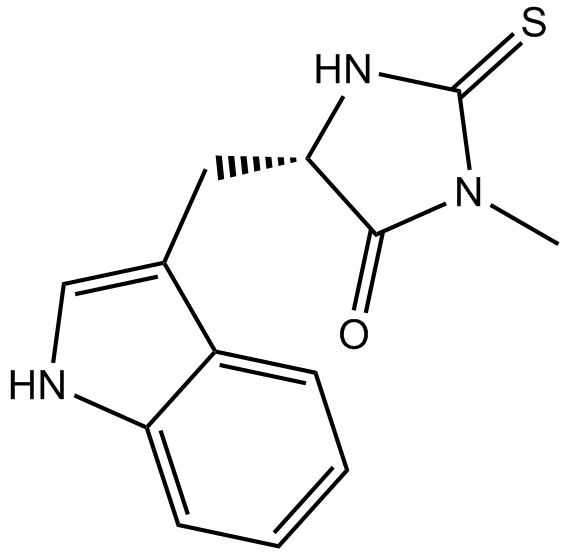Necrostatin-1 (Synonyms: MTH-DL-Tryptophan,Nec-1) |
| Catalog No.GC11008 |
Necrostatin-1 mainly acts on RIP1 in cells [5], Necrostatin-1 is a RIP1 kinase inhibitor with an IC50 value of 0.32 mM.
Products are for research use only. Not for human use. We do not sell to patients.

Cas No.: 4311-88-0
Sample solution is provided at 25 µL, 10mM.
Necrostatin-1 mainly acts on RIP1 in cells [5], Necrostatin-1 is a RIP1 kinase inhibitor with an IC50 value of 0.32 mM[1]. Necrostatin-1 can effectively inhibit RIP1 autophosphorylation, Necrostatin-1 effectively blocks RIP1-RIP3-MLKL signaling by inhibiting RIP1 phosphorylation [7]. Necrostatin-1 is also an IDO inhibitor[2].
Under oxidative stress conditions, CMPC mainly displayed a necrotic phenotype and by pretreatment with Necrostatin-1, we observed a 37 ± 8% reduction in necrotic cell death in CMPCs compared with vehicle. Not find differences in apoptotic-mediated cell death. Therefore, Necrostatin-1 increased the survival of CMPCs by inhibiting necrotic cell death [4]. The ratios of apoptotic and necrotic C2C12 cells were increased following CoCl2 treatment, typical necroptotic morphological characteristics were able to observe by TEM, whereas Necrostatin-1 exhibited a protective effect against CoCl2 induced oxidative stress. Treatment with Necrostatin-1 significantly decreased the levels of RIP1, p ERK1/2, HIF 1α, BNIP3 and ROS induced by CoCl2, and promoted C2C12 differentiation. Necrostatin-1 reversed the CoCl2 induced decrease in mitochondrial membrane potential [6].
In mice,Necrostatin-1 (Nec-1), a specific inhibitor of the receptor-interacting protein 1 (RIP1) kinase domain, prevented osmotic nephrosis and CIAKI, whereas an inactive Necrostatin-1 derivate (Nec-1i) or the pan-caspase inhibitor zVAD did not. Necrostatin-1 prevented RCM-induced dilation of peritubular capillaries, suggesting a novel role unrelated to cell death for the RIP1 kinase domain in the regulation of microvascular hemodynamics and pathophysiology of CIAKI[3].
References:
[1]: Xie T, Peng W, et,al. Structural basis of RIP1 inhibition by necrostatins. Structure. 2013 Mar 5;21(3):493-9. doi: 10.1016/j.str.2013.01.016. PMID: 23473668.
[2]: Degterev A, Huang Z, et,al. Chemical inhibitor of nonapoptotic cell death with therapeutic potential for ischemic brain injury. Nat Chem Biol. 2005 Jul;1(2):112-9. doi: 10.1038/nchembio711. Epub 2005 May 29. Erratum in: Nat Chem Biol. 2005 Sep;1(4):234. PMID: 16408008.
[3]: Linkermann A, Heller JO, et,al. The RIP1-kinase inhibitor necrostatin-1 prevents osmotic nephrosis and contrast-induced AKI in mice. J Am Soc Nephrol. 2013 Oct;24(10):1545-57. doi: 10.1681/ASN.2012121169. Epub 2013 Jul 5. Erratum in: J Am Soc Nephrol. 2014 Dec;25(12):2942. PMID: 23833261; PMCID: PMC3785275.
[4]: Feyen D, Gaetani R, et,al. Increasing short-term cardiomyocyte progenitor cell (CMPC) survival by necrostatin-1 did not further preserve cardiac function. Cardiovasc Res. 2013 Jul 1;99(1):83-91. doi: 10.1093/cvr/cvt078. Epub 2013 Apr 3. PMID: 23554461.
[5]: Degterev A, Hitomi J, et,al.Identification of RIP1 kinase as a specific cellular target of necrostatins. Nat Chem Biol. 2008 May;4(5):313-21. doi: 10.1038/nchembio.83. PMID: 18408713; PMCID: PMC5434866.
[6]: Chen R, Xu J, et,al.Necrostatin-1 protects C2C12 myotubes from CoCl2-induced hypoxia. Int J Mol Med. 2018 May;41(5):2565-2572. doi: 10.3892/ijmm.2018.3466. Epub 2018 Feb 6. PMID: 29436688; PMCID: PMC5846651.
[7]: Degterev A, Huang Z, et,al. Chemical inhibitor of nonapoptotic cell death with therapeutic potential for ischemic brain injury. Nat Chem Biol. 2005 Jul;1(2):112-9. doi: 10.1038/nchembio711. Epub 2005 May 29. Erratum in: Nat Chem Biol. 2005 Sep;1(4):234. PMID: 16408008.
Average Rating: 5 (Based on Reviews and 30 reference(s) in Google Scholar.)
GLPBIO products are for RESEARCH USE ONLY. Please make sure your review or question is research based.
Required fields are marked with *










